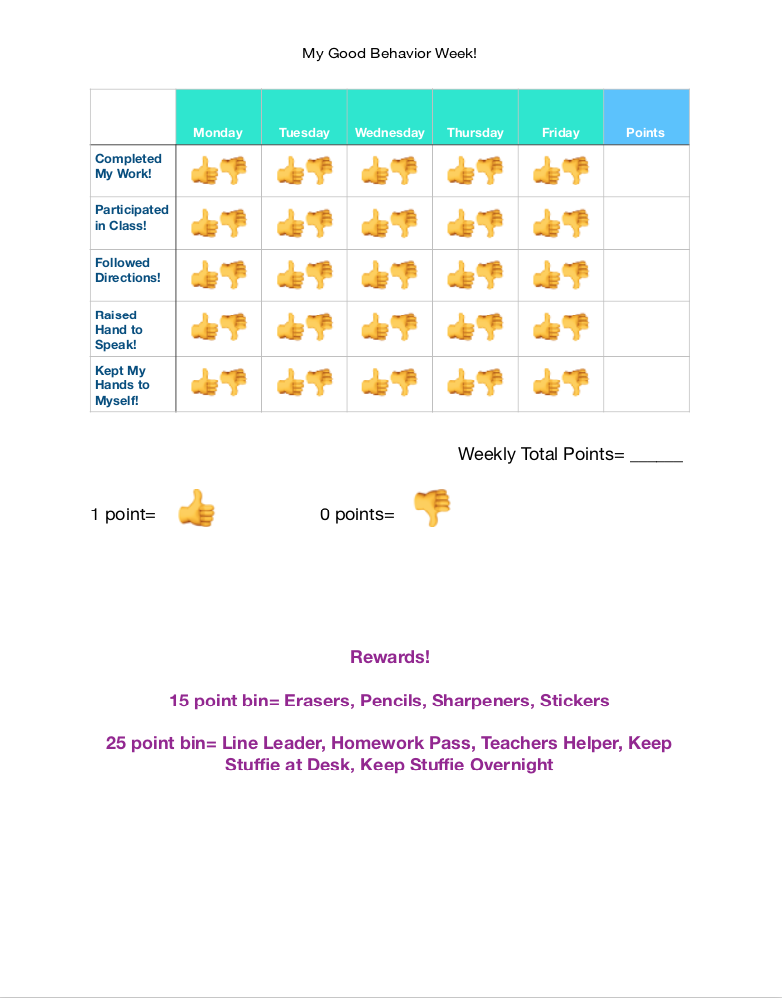Applying Classroom Rules and Procedures
Plans to Avoid Misbehavior
In my classroom, I plan to set up a positive classroom environment. I can accomplish this by learning student’s names, taking an interest in their activities, and understanding student’s family backgrounds. Physical behaviors can also help to develop positive interactions. A hug, high five, or even a smile can go a long way when greeting students by creating a meaningful caring relationship between student and teacher. Classroom setup can also aid in developing a positive classroom environment. I plan to group children together in cooperative grouping in order to create teamwork in the classroom. Click the button below to learn more about creating a positive climate in the classroom.
With the help of my students, I also plan to create a set of rules, norms, and procedures to avoid many behavioral issues in the classroom. Effective teachers not only plan for classroom management before the beginning of the school year but also spend time at the beginning of the school year making sure that students understand the rules and procedures, that students generally accept the rules and procedures, and that students practice procedures enough to execute them in a routine fashion (Marzano, 2007). The utility of rules and procedures is enhanced if students have input into their design. Once I have presented the rules, my students can come up with specific behaviors and routines to make sure the rules are followed (Marzano, 2007). This should happen at first in the beginning of the school year during a presentation/discussion class on rules and expectations. Later in the year the rules can be considered again by the class and perhaps changed. Check out the powtoon video below to hear more about creating rules, norms, and procedures!
I also will have high expectations of myself as a teacher and of my students to accomplish their learning goals! This will help cut down on behavioral issues because having high expectations directly effects the student’s ability to achieve in the classroom. “A teacher’s beliefs about students’ chances of success in school influence the teacher’s actions with students, which in turn influence students’ achievement” (Marzano, 2007). Students who are low-performing need to have high expectations in order to boost their confidence and self image. Without this, they will be more likely to act out in class. The students need to know that I believe in them so they can achieve greatness in the classroom.
Because behavioral issues are bound to arise despite my plans and expectations, I plan to use a behavior chart to help manage classroom behavior. This behavior chart and point system could be used class wide, or for specific students who are having behavioral issues. It is a rewards based system that is used on a weekly basis so both the students and the teacher can see progress throughout the week. In order to avoid star students always being “on top” and struggling students never being able to reach point goals, the points will be reset every week. This shows students that each week is a fresh new start for them to meet their goals! This behavior chart will help students be reminded of the teachers behavioral and academic expectations. In addition, at the end of the week the teacher will send home the behavioral chart to be signed by the parents. For students who are not achieving expectations, the teacher will fill out the back of the behavioral chart. The back includes a place to write a note for the parents to read and 3 simple categories: Improving, Staying the Same, and Worsening.

Plans to Manage Misbehavior
Even with this behavioral chart motivating students to do their best in class, there will still be situations that I need to address misbehavior. First, I need to be very clear about my expectations. I need to give specific, concrete, sequential, and observable directions (W.T.D). This makes it very clear to the student what it is I want them to do.
Second, I need to give praise to students who are following instructions well. This is called positive narration. When I see a student doing something positive such as working quietly, listening intently, or sharing well I need to comment on the behavior. If I do this in front of classmates, the student will feel happy and proud and the classmates will desire to have that same attention drawn to them. Therefore, they will listen better to rules and directions. If all of these attempts to manage the classroom do not work for a specific student, the next step would be for me and the student to have a private conversation. This conversation could refocus the student gently by supporting her emotions and recognizing her needs. In my classroom I plan to figure out each student’s needs by asking them questions about what works for them. Just spending this time to get to know students needs will create a bond between me and my students. Finally, if the behavior continues it is necessary for the parents, and principal to be brought in for a meeting with me and the students for a final attempt to dispel the misbehavior. This is not a punishment, but an aid for both me and the student to develop a positive relationship based on communication. We can all work together to find an appropriate consequence that will help the student get back on track in the classroom.
0 Comments
Leave a Reply. |
Details
AuthorKristen Fallon: Student, Teacher, Musician, Fun loving person! Archives
March 2019
Categories |



 RSS Feed
RSS Feed
